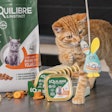
‘Tis the season for prognosticating on trends – pet food trends, human food trends, you name it – and, in a new twist, reviewing trends predicted the year before as to whether they actually developed. So I’ll play along: How did the human food trends I thought would have the most impact on pet foods this year pan out?
Seeds of change and waves of grain
One human food trend I highlighted last year was identified by Innova Market Research as “seeds of change”: the increasing popularity of healthy ingredients like chia seeds, which have also been used in pet foods and treats for some time now. The trend also encompasses ancient grains like quinoa, amaranth, spelt and millet, which are some of the hottest items in human diets these days. With pet food following human food so closely, it seemed worth wondering: Could the interest in ancient grains expand to pet food, despite the continuing dominance of grain-free products in the latter market? Could ancient grains even be the next big thing in pet food?
The possibility was intriguing enough for Kansas State University (KSU) to build its Pet Food R&D Showcase, held in October 2017, on ancient grains as a theme. Grain-free craze aside, a full 80 percent of the total US pet food market is still comprised of conventional ingredients like grains, said Greg Aldrich, PhD, coordinator of KSU’s pet food program (and longtime industry nutrition consultant and author of the Ingredient Insights column), citing data from Packaged Facts.
New data from GfK on the US pet specialty retail channel may be starting to bear that out. “While remaining a tiny category overall (only 0.5 percent of all ‘with grain’ pet food sales), items with ancient grains have more than doubled in sales since 2015, from about US$9 million to US$19 million in 2017,” wrote Maria Lange, business group director of GfK’s pet POS tracking team, on PetBusiness.com.
We probably shouldn’t get too excited about that; besides this specific category being so small, the overall category of pet foods with grains of any type “has been declining at a pretty steady rate (minus 5 percent) for the past two years,” Lange wrote. “At the same time, the grain-free trend continues to surge, with many new brands entering the space. Even the ones that swore off grain-free many years ago have jumped onto the grain-free bandwagon, taking the trend mainstream at last.”
Yet it’s worth remembering that the pet food market, like others, is cyclical, and the grain-free boom is naturally destined to go bust (or at least slow down) eventually. So it makes sense to think about what might come next. An executive from a smaller pet food manufacturer remarked during the Pet Food R&D Showcase that his company tries to position itself as a leader in trends and product development; now that everyone, including the “big guys,” are doing grain-free, it’s time for his company to move on to something else. He didn’t say whether ancient or other grains was that next something, but whatever it is, if it resonates with pet owners, other companies are likely to soon follow.
Plants powering pet food
Closely related to seeds and grains, another human food trend that seemed to have implications for pet food was what Innova called “disruptive green.” In human food, this meant plants going mainstream, showing up in all sorts of products; Innova reported in late 2016 that the number of new human food and beverage products launched globally with a plant-related claim leaped from 100 in 2011 to nearly 700 that year.
With cats being obligate carnivores and dogs, omnivores that definitely love and thrive on meat, this trend isn’t quite so clear cut in pet foods. Yet research is proving that plant-based proteins can provide for dogs’ nutritional needs and, at least supplementally, for cats’; in fact, there are a couple of vegetarian dog foods on the market, such as from Petcurean in Canada and Josera in Germany.
In addition, newer plant-based proteins such as soy press cake, potato proteins, grass and beet leaves, brewer’s spent grains, duckweed and algae are getting attention, while research continues to prove the protein benefits of more traditional ingredients like pulses, soybeans, lupin and other beans, potatoes, wheat and corn. As experts around the world seek new, more sustainable sources of protein for a growing human (and pet) population, plant-based sources will continue to be an attractive alternative. For pet food, they’re even being looked at as a source of palatants.
Clean label is here to stay – at least for a while
Finally, “clean supreme,” a trend titled by Innova as an expansion and extension of the clean label craze, was a no-brainer for pet food. For several years now, pet owners have been seeking more information about the pet foods they buy and particularly the ingredients in them: not only what those substances are but where they come from, how they are harvested and more. That only ramped up this year.
For example, a survey conducted by Nutro earlier in 2017 showed that 90 percent of US dog owners try to eat to meet “clean food” criteria for humans, and 75 percent said their clean-eating efforts influence what they feed their dogs. In a separate survey, Open Farm pet food found that 90 percent of US pet owners think it’s important that the pet foods they purchase provide transparency on ingredients, and 84 percent said they pay as much attention to the ingredients in their pets’ food as in their own food.
To many consumers, whether they’re purchasing pet food or human food, the term “clean label” now goes beyond just the number of ingredients on the label and the names of the ingredients themselves, extending to sourcing and production. Think of label claims like “farm grown,” “sustainably produced” and “minimally processed” and, for proteins derived from livestock, “antibiotic and hormone free” and “humanely raised.” That tells me that this trend is likely here to stay, at least for another year.


















